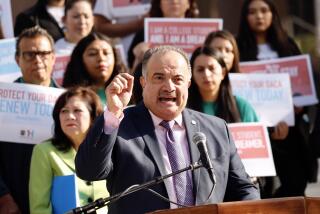Ralph Prator, 97; Founding President of Campus That Became Cal State Northridge
- Share via
Ralph Prator, whose 10-year term as the first president of what later became Cal State Northridge was characterized by tremendous growth and tension within the student body, has died. He was 97.
Prator died Monday at his home in Camarillo, according to the university. No cause of death was given.
Prator helped transform the San Fernando Valley’s fledging satellite campus of Los Angeles State College into an institution with a solid reputation of its own. His appointment to the presidency in 1958 coincided with the renaming of the campus as San Fernando Valley State College.
During the next decade he oversaw massive construction, including nine multimillion-dollar buildings. He also saw enrollment grow from 3,500 to 16,000 students and its faculty multiply by six times from its original 100 or so.
The college, which became Cal State Northridge, or CSUN, in 1972 when the state college system converted to a university system, now has nearly 33,000 students.
“His strong leadership was a vital factor in the institution’s development of intellectual excellence as well as in the building of a beautiful campus,” James Cleary, the college’s second president, told the Los Angeles Times several years ago.
CSUN’s current president, Jolene Koester, said in a statement Tuesday: “As the founding president, [Prator] gave us a solid foundation upon which to build the university’s excellence.”
During Prator’s tenure, escalating student protests over the lack of minority students and related programs -- in addition to the Vietnam War -- took their toll. Shortly after stepping down as president in September 1968, Prator told The Times that he believed that a college president’s role had become more oriented toward crisis than education.
“The [college] president has been thrown into the maelstrom of social, political and educational problems. And these problems have sapped his energies and destroyed his morale,” Prator said. “New sources of power have asserted themselves -- students, faculty, public -- and the administrator has been hung out to dry. He is, in effect, saddled with increasing responsibilities and given diminishing authority to deal with them.”
After his resignation, Prator would stay on campus six years as a professor of education. Shortly after he left the presidency, members of the Black Student Union held 34 administrators and other workers hostage in the administration building, demanding increased minority enrollment and staff and the creation of African American and Mexican American studies departments. After the two departments were created, campus protests focused on the Vietnam War.
Born Nov. 16, 1907, to a ranching family in La Veta, Colo., Prator earned a bachelor’s degree in history at the University of Colorado at Boulder in 1929 and embarked on a career in professional baseball. A back injury foiled his plans.
After earning a master’s degree in history from the University of Colorado, he started his career in education. He was a high school principal before becoming dean of men and athletic director at Mesa College in Colorado in 1936. After joining the University of Colorado in 1940, he held a variety of administrative positions before taking leave to serve as a lieutenant commander in the Navy during World War II. In 1947, he received a doctoral degree in educational administration from UC Berkeley.
He became president of Bakersfield College in 1950 and oversaw major construction on the campus, which would prove to be important training for his next, and most prestigious, position. In 1958, he was appointed president of San Fernando Valley State College, which had been launched about two years earlier in leased classrooms at San Fernando High School.
Prator predicted that the 165-acre college then surrounded by orange groves would need substantially more land to meet future student enrollment. He successfully lobbied then-Gov. Pat Brown to get the nearby Devonshire Downs fairgrounds at Devonshire Street and Zelzah Avenue deeded to the college. An additional 70 acres that separated the main campus from the fairgrounds eventually became part of the campus, expanding it to more than 350 acres.
The construction was so quick that it seemed as if the college was experiencing “five years in one,” Prator told The Times in 1960.
To meet the need for more professors, Prator and Delmar Oviatt, then dean of instruction, would head to the coldest parts of the country each Jan. 2, armed with an attractive recruiting tool: photos of students in short-sleeved shirts enjoying the balmy Valley weather. Prator would see as many as 30 prospects in a day.
In December 1967, amid increasing student protests over racial issues, Prator announced that he would step down as president and teach education courses. Being in the classroom, he later said, provided him a more orderly life and a new appreciation for the faculty and students who “have a way of compensating you, appreciating a good job of teaching and tending to forgive a bad one.”
After retirement, Prator moved to Camarillo’s Leisure Village, where he kept active into his 90s playing golf and bridge and exercising at a nearby naval base.
Prator, whose wife, Lois, died in 1996, is survived by his sons Bruce of Oregon and Lewis of Fountain Valley; daughter Roxanna Gottsacker of New Hampshire; four grandchildren; and a sister, Elizabeth Bryan of Oklahoma.
No public services are planned. Instead of flowers, donations may be made to the CSUN student scholarship established by Prator and his wife at Cal State Northridge Foundation, 18111 Nordhoff St., Northridge, CA 91330-8275.
*
This article was written by Stassel, a former Times staff writer, and updated by staff writer Claudia Luther.
More to Read
Sign up for Essential California
The most important California stories and recommendations in your inbox every morning.
You may occasionally receive promotional content from the Los Angeles Times.













